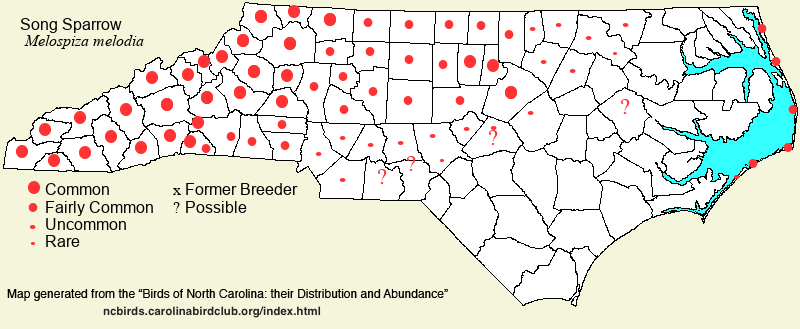 |  |
|
Song Sparrow - Melospiza melodia PASSERELLIDAE Members: | Search Common: Search Scientific: |
|
|
|||||||
| General Comments | The Song Sparrow is one of the most abundant and successful species in North America, breeding from Alaska and Newfoundland south through much of the United States; it winters across most of the United States and southern Canada. Though it winters in large numbers across all of North Carolina, in the breeding season it is restricted to the mountains and Piedmont, and along the northern and central coastal areas. It is arguably the most abundant breeding bird in the state's mountains, as well as one of the state's more abundant wintering species. In the breeding season, it has different habitats in the different regions. In the mountains and foothills, it occurs in farmyards, towns, open residential areas, and other partly open, shrubby sites. In the central and eastern Piedmont, it is mainly restricted to cities and towns, where there is shrubbery and some lawns or grassy areas; in rural country it is often absent. In the Coastal Plain, it nests essentially only along the immediate coast, south to Cedar Island; favored habitats are shrubs or saplings mixed with grassy areas, such as in maritime shrub thickets. At other seasons, they occur in a wide array of weedy fields, hedgerows, brushy areas, and wooded margins, including shrubby marshes. The species did not begin nesting in North Carolina until the 1890's in the mountains. In the 1960's, the species was rather rare and local as a breeder in the southern and eastern Piedmont, but it has steadily increased since then. | ||||||
| Breeding Status | Breeder | ||||||
| NC BRC List | Definitive | ||||||
| State Status | |||||||
| U.S. Status | |||||||
| State Rank | S5B,S5N | ||||||
| Global Rank | G5 | ||||||
| Coastal Plain | Winter resident, and (northern) coastal breeder. In summer, generally common, though can be local, along the barrier islands, south to Portsmouth Island, and also at the northern end of Cedar Island, where uncommon. Inland, the only summer reports are: one singing at Southern Pines from 3-7 Jun 1999; single singing birds in Rocky Mount and Wilson in summer 2009; Pinehurst from 21 May - 8 Jun 2018, and singing in southeastern Pitt on several dates in Jun-Jul 2024. [It would be little surprise if the species began nesting in a few of these or other towns that lie along the western edge of the region, in the next few years.] At other seasons, common to abundant throughout. Mainly early or mid-Oct to mid-Apr. Peak counts: | ||||||
| Piedmont | Permanent resident, with migratory movements; much more common in winter. In summer, common and widespread in the western/foothill portion, fairly common to common in the central areas, but mostly in cities and towns; and fairly common in the eastern and southern portions, but essentially only in cities and towns. Still spreading into more areas in the eastern Piedmont as a breeder. Ranges southeast to Troy (Montgomery). At other seasons, common to abundant throughout. Peak counts: | ||||||
| Mountains | Permanent resident, with migratory movements. Very common at all seasons at low to mid-elevations; very common breeder to the highest peaks, but generally uncommon at high elevations in winter. Peak counts: | ||||||
| Finding Tips |
None needed. **** | ||||||
| Attribution | LeGrand[2024-11-08], LeGrand[2023-03-31], LeGrand[2020-04-18] | ||||||
| NC Map Map depicts all counties with a report (transient or resident) for the species. | Click on county for list of all known species. |
| NC Breeding Season Map Map depicts assumed breeding season abundance for the species. |  |